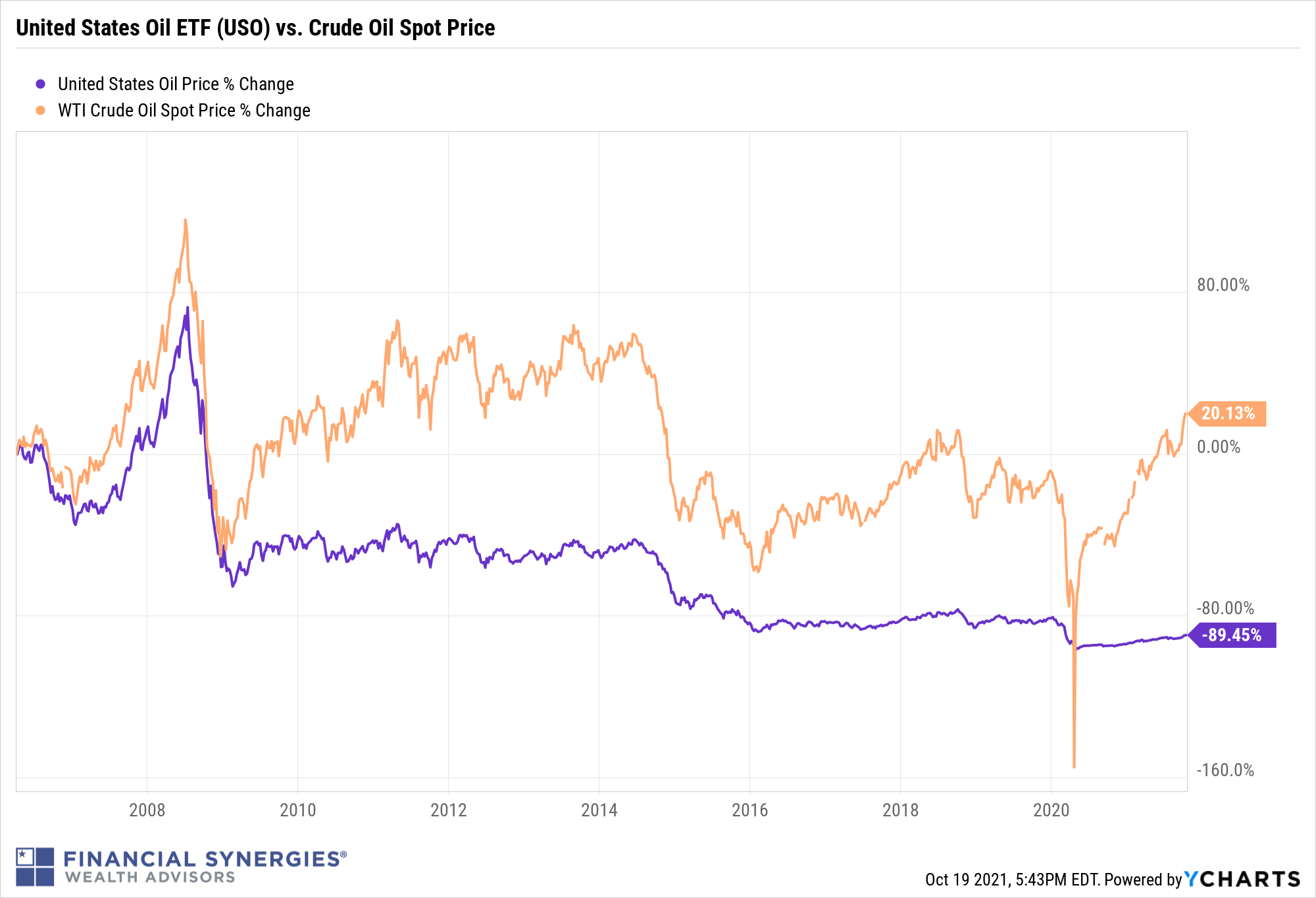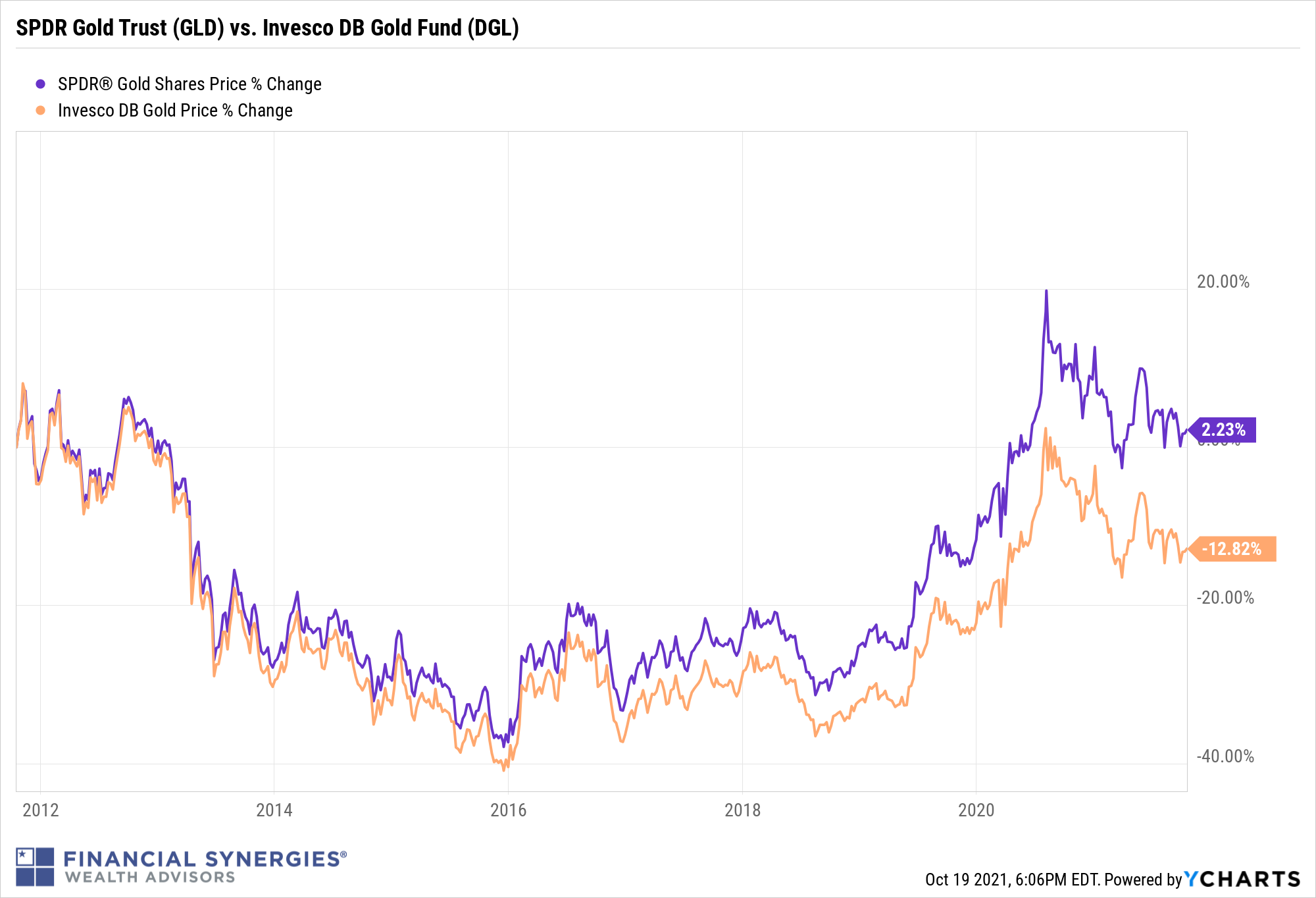Fair warning to those looking for direct exposure to Bitcoin – you will not find it in these new ETFs. That’s because they are investing in Bitcoin futures contracts, not Bitcoin. The first of these ETFs launched today – ProShares Bitcoin Strategy ETF (BITO), and several more are expected to launch in the coming weeks and months. For the time being, this futures-based ETF structure is all that the SEC will allow, though I suspect a more direct investment ETF is only a matter of time.
The biggest problem with futures-based funds is that they invest in contracts that expire, and then have to buy new contracts to replace them. So, by virtue of investing in bitcoin futures, what you see is that there are some issues related to maintaining that exposure. It’s the intention of most of these ETFs to invest in the front-month futures contract. That front-month futures contract, like any futures contract, is going to expire.
When that futures contract expires, the funds will have to invest in another month’s futures contract. And what can happen in the process is that if that next futures contract, or those next futures contracts, are trading at prices that are above the ones that the fund currently owns, they will be in effect systematically selling low and buying high.
In futures markets, this is known as contango, which is essentially a way to lose money by trying to maintain exposure to an underlying commodity, or bitcoin in this instance, by virtue of investing in it through regularly rolling futures contracts.
Depending on the steepness of the futures curve, this can be extremely costly. And indeed, we’ve seen this movie before with oil & gas futures contracts and the ETFs that have offered investors exposure to those underlying commodities. Many investors in these oil and gas ETFs (futures-based) got a rude awakening when their performance looked nothing like the performance of the underlying commodities.
Here’s some disclosure from United States Natural Gas ETF (UNG): UNG invests solely in front-month futures contracts. This means that the fund will be particularly sensitive to changes in spot prices, but may be priced higher or lower than spot, sometimes dramatically.
Here’s another case in point – The United States Oil Fund ETF (USO) which is designed to track the spot price of WTI crude oil. The dramatic long-term underperformance of this ETF versus the actual price of oil is due to it’s futures-based structure and the phenomenon known as contango. See below – ouch.
The United States Oil Fund ETF (USO) VS. WTI Crude Oil Spot Price

To be fair, it has been well documented that while these ETFs do a good job of tracking prices over short periods of time, they have significantly underperformed the markets they are designed to track over longer periods. Thus, they are more appropriate for short-term traders who want to speculate on price movements.
The problem is that many investors go into these funds thinking they are going to track the underlying asset (oil, gas, Bitcoin, etc.) over the long-term closely, and then are shocked by the discrepancy in performance.
Here’s another cautionary tale – and a particularly fitting one given that Bitcoin has been likened to digital gold. The SPDR Gold Trust (GLD) holds gold itself, while the Invesco DB Gold Fund (DGL) holds gold futures. On a ten-year timeline, the SPDR fund has risen 2.23%, while the Invesco fund is down -12.82%. Another ouch.

Ok, I’ll stop beating a dead horse here. It’s too early to tell how well these new Bitcoin ETFs will manage to track the actual performance of the cryptocurrency. Just proceed with caution.
THE BOTTOM LINE
Be careful with these types of ETFs. Understand what you are buying. Your results may be far different than what you expect, particularly over long periods.
We are not shunning Bitcoin. We continue to take a very deliberate approach with all cryptocurrencies, or digital assets. We simply don’t have enough data to determine their viability as a long-term asset class. But, our research continues for now.
If you must invest directly in Bitcoin, please contact your financial advisor. There are some alternatives to these funds we can discuss together.
The New Bitcoin ETFs: They don’t invest directly in Bitcoin
Fair warning to those looking for direct exposure to Bitcoin – you will not find it in these new ETFs. That’s because they are investing in Bitcoin futures contracts, not Bitcoin. The first of these ETFs launched today – ProShares Bitcoin Strategy ETF (BITO), and several more are expected to launch in the coming weeks and months. For the time being, this futures-based ETF structure is all that the SEC will allow, though I suspect a more direct investment ETF is only a matter of time.
The biggest problem with futures-based funds is that they invest in contracts that expire, and then have to buy new contracts to replace them. So, by virtue of investing in bitcoin futures, what you see is that there are some issues related to maintaining that exposure. It’s the intention of most of these ETFs to invest in the front-month futures contract. That front-month futures contract, like any futures contract, is going to expire.
When that futures contract expires, the funds will have to invest in another month’s futures contract. And what can happen in the process is that if that next futures contract, or those next futures contracts, are trading at prices that are above the ones that the fund currently owns, they will be in effect systematically selling low and buying high.
In futures markets, this is known as contango, which is essentially a way to lose money by trying to maintain exposure to an underlying commodity, or bitcoin in this instance, by virtue of investing in it through regularly rolling futures contracts.
Depending on the steepness of the futures curve, this can be extremely costly. And indeed, we’ve seen this movie before with oil & gas futures contracts and the ETFs that have offered investors exposure to those underlying commodities. Many investors in these oil and gas ETFs (futures-based) got a rude awakening when their performance looked nothing like the performance of the underlying commodities.
Here’s some disclosure from United States Natural Gas ETF (UNG): UNG invests solely in front-month futures contracts. This means that the fund will be particularly sensitive to changes in spot prices, but may be priced higher or lower than spot, sometimes dramatically.
Here’s another case in point – The United States Oil Fund ETF (USO) which is designed to track the spot price of WTI crude oil. The dramatic long-term underperformance of this ETF versus the actual price of oil is due to it’s futures-based structure and the phenomenon known as contango. See below – ouch.
The United States Oil Fund ETF (USO) VS. WTI Crude Oil Spot Price
To be fair, it has been well documented that while these ETFs do a good job of tracking prices over short periods of time, they have significantly underperformed the markets they are designed to track over longer periods. Thus, they are more appropriate for short-term traders who want to speculate on price movements.
The problem is that many investors go into these funds thinking they are going to track the underlying asset (oil, gas, Bitcoin, etc.) over the long-term closely, and then are shocked by the discrepancy in performance.
Here’s another cautionary tale – and a particularly fitting one given that Bitcoin has been likened to digital gold. The SPDR Gold Trust (GLD) holds gold itself, while the Invesco DB Gold Fund (DGL) holds gold futures. On a ten-year timeline, the SPDR fund has risen 2.23%, while the Invesco fund is down -12.82%. Another ouch.
Ok, I’ll stop beating a dead horse here. It’s too early to tell how well these new Bitcoin ETFs will manage to track the actual performance of the cryptocurrency. Just proceed with caution.
THE BOTTOM LINE
Be careful with these types of ETFs. Understand what you are buying. Your results may be far different than what you expect, particularly over long periods.
We are not shunning Bitcoin. We continue to take a very deliberate approach with all cryptocurrencies, or digital assets. We simply don’t have enough data to determine their viability as a long-term asset class. But, our research continues for now.
If you must invest directly in Bitcoin, please contact your financial advisor. There are some alternatives to these funds we can discuss together.
Recent Posts
Financial Synergies Completes 20-Year Internal Succession, Names Eight New Partners
Monthly Market Update: Rising Policy Uncertainty Leads to Increased Market Volatility
Lessons from Warren Buffett for Today’s Investors
Subscribe to Our Blog
Shareholder | Chief Investment Officer